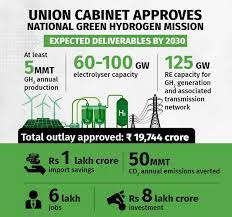The National Green Hydrogen Mission (NGHM) is a significant initiative launched by the Indian Government to promote the production and use of green hydrogen as an alternative to fossil fuels. The mission aims to create a green hydrogen ecosystem in the country, which will not only help reduce India’s carbon footprint but also create employment opportunities and boost the economy.

Table of Contents
What is Green Hydrogen?
Green hydrogen is produced by electrolysis of water using renewable energy sources like solar or wind power. Unlike grey hydrogen, which is produced from fossil fuels like natural gas, green hydrogen is considered a clean and sustainable fuel with no carbon emissions.
Objectives of National Green Hydrogen Mission
The National Green Hydrogen Mission has set some ambitious targets to achieve by 2030, which includes:
- To establish 28 GW of hydrogen generation capacity
- To reduce the cost of green hydrogen to less than Rs. 100 per kg
- To create a green hydrogen ecosystem in the country by promoting research, development, and deployment of green hydrogen technologies.
- To promote the use of green hydrogen in various sectors like transportation, industry, and power generation.
- To promote domestic manufacturing of green hydrogen and its equipment to reduce dependence on imports.
Key Initiatives Under National Green Hydrogen Mission
The NGHM has planned various initiatives to achieve its objectives, which includes:
- Establishment of a National Hydrogen Energy Board (NHEB) – The NHEB will act as the apex body to coordinate and facilitate the implementation of the mission. It will comprise representatives from various ministries, research institutions, and industry bodies.
- Setting up of Hydrogen Hubs – The mission will set up hydrogen hubs across the country to promote the production, storage, and distribution of green hydrogen. These hubs will act as centres of excellence for research and development of green hydrogen technologies.
- Promotion of Research and Development – The mission aims to promote research and development in the field of green hydrogen by setting up research institutions, providing grants and funding for R&D projects, and organizing workshops and seminars.
- Creation of Demand for Green Hydrogen – The mission will promote the use of green hydrogen in various sectors by providing incentives and subsidies for the purchase of green hydrogen-based vehicles, equipment, and appliances.
- Manufacturing of Green Hydrogen Equipment – The mission will promote domestic manufacturing of green hydrogen equipment like electrolyzers, fuel cells, and storage tanks to reduce dependence on imports and create employment opportunities.
Benefits of National Green Hydrogen Mission
The National Green Hydrogen Mission has the potential to bring various benefits to India, which includes:
- Reduction in Carbon Emissions – Green hydrogen is a clean and sustainable fuel with no carbon emissions. The widespread use of green hydrogen can help reduce India’s carbon footprint and contribute to global efforts to mitigate climate change.
- Boost to the Economy – The establishment of a green hydrogen ecosystem in the country can create employment opportunities, promote domestic manufacturing, and reduce India’s dependence on fossil fuels.
- Energy Security – India currently imports a significant amount of its energy requirements. The promotion of green hydrogen can help reduce the dependence on imports and enhance the country’s energy security.
- Improved Air Quality – The use of green hydrogen-based vehicles and equipment can help improve the air quality in the country, which is a significant concern in many urban areas.
Challenges and Way Forward
The National Green Hydrogen Mission faces some significant challenges, which includes:
- High Cost – The cost of green hydrogen is currently higher than fossil fuels, which makes it less competitive in the market. The mission aims to reduce the cost of green hydrogen by promoting research and development and domestic manufacturing.
- Infrastructure – The production, storage, and distribution of green hydrogen require significant infrastructure investments.
- Scale – Scaling up the production and distribution of green hydrogen to meet the ambitious targets of the National Green Hydrogen Mission is a significant challenge. It requires significant investments in infrastructure and technology.
- Public Awareness – Awareness and acceptance of green hydrogen among the public are crucial for the success of the mission. The government needs to promote awareness campaigns and educate the public about the benefits of green hydrogen.
Steps Required
To overcome these challenges, the government needs to take a multi-pronged approach, which includes:
- Investment in R&D – The government needs to invest in research and development to improve the efficiency and reduce the cost of green hydrogen production.
- Infrastructure Development – The government needs to invest in infrastructure development, including the establishment of hydrogen hubs, to promote the production, storage, and distribution of green hydrogen.
- Incentives and Subsidies – The government needs to provide incentives and subsidies to promote the adoption of green hydrogen in various sectors like transportation, industry, and power generation.
- Collaboration – Collaboration between the government, industry, and academia is essential for the success of the mission. The government needs to collaborate with industry bodies and research institutions to promote the development and deployment of green hydrogen technologies.
Conclusion
The National Green Hydrogen Mission is a significant step towards a cleaner and sustainable energy future for India. The mission has set ambitious targets and planned various initiatives to achieve them. The successful implementation of the mission requires a collaborative effort between the government, industry, and academia. With the right investments and policies, India can become a global leader in the production and use of green hydrogen.
Important Links